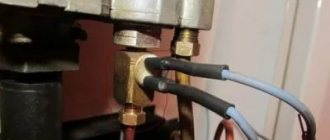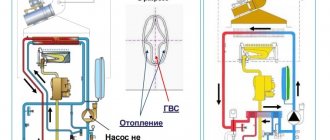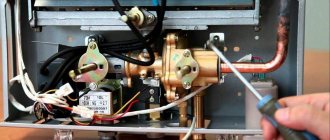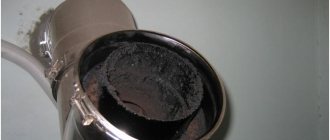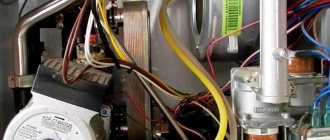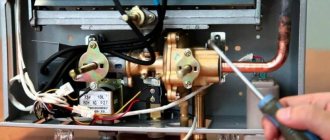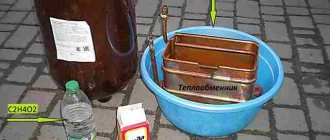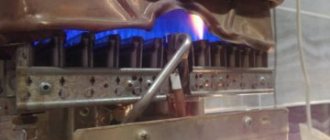Gas autonomous heating is the best option for a private home, as it is cheap, reliable and efficient. However, sometimes the equipment begins to malfunction, and as a result, the home may find itself without heat at the height of the cold season. Therefore, we will analyze why a gas boiler does not turn on, what are the characteristics of the main problems - poor draft, pressure drop, electronic malfunction - and how to correct them correctly in order to quickly restore the functionality of the heating system.
Only professional diagnostics can quickly find the exact cause of a gas boiler breakdown Source eurosantehnik.ru
Primary diagnostics of a gas boiler
First of all, you need to understand why the gas boiler does not turn on. Modern models help a person quickly find the answer to this question. They are equipped with an internal diagnostic system, which signals a breakdown with a code or icon on the control panel. All you have to do is look at the meaning of the message in the instructions. And do the repairs yourself or call a specialist.
For older models or those that do not have self-diagnosis, you will have to determine why the gas boiler does not heat in another way. All faults can be divided into external and internal.
External faults include:
- Low pressure.
- Chimney problems.
- Voltage drop.
- It's cold inside.
- Constant drafts.
Internal faults, when we can say that the gas boiler is broken, include:
- Problems with the sensor.
- Wiring fault.
- Failure of parts - pump, heat exchanger, etc.
Review of manufacturers
Gas services, as well as experts in this field, recommend using boilers from the company.
The units are presented in several versions and differ in functional features. Boilers are produced only of floor type. The main difference from other analogues is the affordable price and the lack of electricity required for operation.
Keber boilers are also popular; they are equipped with an automatic safety and regulation system, which ensures precise gas supply and temperature stabilization.
Gas boilers of the AOGV series are quite in demand and are used to heat rooms that have a water heating system with natural or artificial circulation.
(Termotechnik) presents a large selection of boilers and offers floor-mounted, parapet-type, gas and solid fuel units. Many years of experience ensures excellent quality and guarantees product reliability and long service life.
Eliminating problems associated with blowing out the boiler requires special care and responsibility. It is necessary to check all components of the boiler to determine and eliminate the cause of the malfunction. If the recommendations presented do not bring results, it is worth calling the gas service specialists. Remember that quickly getting rid of problems will prevent additional breakdowns and protect not only the entire system, but also the residents of the house.
Watch the video in which a specialist examines one of the most common reasons: why a gas boiler goes out in the wind, what needs to be done, what work needs to be done to improve draft in the boiler:
Gas boilers are the most economical type of heat generators, easy to install and subsequently operate, used in autonomous heating systems. However, like any engineering equipment, gas boilers can sometimes fail, and the most common type of failure is self-extinguishing burner. To understand why a gas boiler goes out or find out the cause of other problems, you need to know about the types of boilers and the principles of their operation.
Solving ventilation problems
The reason why a gas boiler does not turn on is often hidden in the ventilation system. This is especially true for models with an open camera. Since there will be no flame without an influx of oxygen from outside.
What you need to do: think about the ventilation in the room. Install special valves on the windows or simply open them.
If the gas boiler does not heat water, check if there is draft. Light a match and bring it to the window or outlet. When everything is in order with the draft, the flame tends to the side. If there is a problem, it burns straight. We need a chimney inspection.
The boiler does not light up
If a gas boiler does not ignite, then in most cases there will be an error signal on the information panel indicating its number or code, by which you can approximately find out in which boiler system the malfunction occurred and how critical it is. All double-circuit boilers provide switching between summer and winter operating modes. In summer mode, the boiler will not turn on to heat the room (the same is true when using weather-compensated automation or thermostats).
If the boiler does not ignite and does not make any attempts to turn on (stands idle) when necessary, this may be an electronic malfunction, but such cases are rare and concern specific boiler models.
Usually, if there is a malfunction that prevents the boiler from operating normally, the user will receive an error. That is, if the boiler does not ignite, you need to determine the error code and find its meaning in the equipment operating manual. Error codes with descriptions are always indicated there.
Next, we will consider the most common boiler malfunctions that users encounter. It is worth mentioning here that mostly all modern boilers have the same basic structure and operating procedure. However, to solve a specific problem on a specific boiler, you need to at least read the instructions for that boiler.
Several unsuccessful ignition attempts
This is the very first error code for most equipment manufacturers. For BAXI E01 boilers, for Arison 501 boilers, for Vaillant F28. Ignition of the gas-air mixture in the combustion chamber will occur under two conditions: the presence of gas at the burner nozzles and the presence of a spark. Gas enters the burner through the gas valve, the spark is generated by a transformer on the control board (or remote). A separate case should be noted when ignition occurs, but the boiler cannot detect the presence of a flame and goes out (closes the gas supply valve).
The most common reasons:
Phasing error
. Often, gas boiler boards require connection polarity. For the average user, this means that the position of the plug in the outlet matters. If the connection polarity is reversed, the boiler does not see the presence of a flame, continues ignition (electrode crackling) even when there is already a flame on the burner, then turns off due to an emergency. Even if you did not touch the plug, the polarity could change at the substation!
Ignition or flame ionization electrode
. It can be separate or combined. The main problems may be related to contamination (oxidation) of the electrode or its gap relative to the burner. A dirty ionization electrode prevents the board from detecting the presence of a flame and operation stops.
High voltage wire. High voltage is generated by a transformer and transmitted through a wire to the electrode, where it pierces the air gap between the burner and the electrode with a spark. If a characteristic crackling sound is heard, but a spark on the burner is not visually visible, it is possible that the breakdown is occurring somewhere else. For example, there is a microcrack in the insulation of a high-voltage wire, and a breakdown occurs at the point where the insulation on the housing is broken.
Electrical connection problems
. The presence of parasitic potentials on the boiler body, lack of grounding or low voltage of the supply network can cause problems with ignition. I often hear the argument: everything used to work without grounding. No one will understand how the boiler worked without grounding. According to the operating instructions, this must be done! For normal operation of the boiler there must be: a network voltage of at least 180 volts, a potential between the neutral and ground wires of up to 10 volts, and the presence of grounding.
No gas on the burner
. The gas valve controls the gas supply to the burner: it opens and modulates (gas dosing). The gas valves are regulated and controlled by a control board. Accordingly, the cause of the problems may be a malfunction of the valve (or the need for adjustment), its electrical part, or the control circuit on the board. This device should be checked by a specialist. The lack of gas can also be due to external factors: a faulty meter, dirty filters.
Control board.
In some cases, lack of ignition or flame control is caused by a malfunction of the boiler main board. This can be considered after the other possible causes as described above have been accurately checked.
Insufficient draft (fan does not turn on)
Also a popular problem. If there is a problem with the removal of combustion products, the boiler will not start and ignite until it is completely eliminated. Such malfunctions and their solutions are described in more detail in a separate article - chimney errors.
Insufficient water pressure (refill required)
Traditional gas boilers operate in a closed heating system; accordingly, to prevent the boiler from turning into a hydrogen bomb, there must be a minimum water pressure inside the heat exchanger (in fact, the presence of water and circulation there). The pressure is controlled by a special sensor - a pressure sensor. The boilers are provided with an additional mechanical pressure gauge for the user. Although the systems are closed, the pressure in them can drop over time (for example, water escapes through leaks in the connections). As soon as the water pressure in the boiler drops below the minimum level (0.5 - 0.7 bar), the boiler sensor detects a malfunction and blocks operation. In most cases, you just need to study the readings of the mechanical pressure gauge and recharge the system according to the instructions for the boiler.
How to repair a gas boiler chimney?
If you have reached the point of diagnosing the chimney, then there is a problem with the draft. It can be expressed in excess, deficiency or reverse thrust. As a result, the wick goes out and that’s why the gas boiler automatically turns off.
Reverse thrust or attenuation may well be due to weather - wind, pressure surges. Therefore, when installing a chimney, you should carefully calculate the height:
- For a flat roof 50 cm is enough.
- If it is 1.5 meters from the ridge of the roof, it should be 50 cm above the ridge.
- At 1.5-3 meters - exactly with the skate.
If you leave this distance, then there will be no difficulties, as well as the fact that the gas boiler does not heat well.
Excessive draft can occur when the hood in the kitchen works too well, which is detrimental. Then you should turn off the hood while the boiler is running.
The gas boiler turns on/off - this is not the only problem that can be due to low or high draft:
- Blockages . Relevant for stationary chimneys. It is necessary to clear the chimney of leaves and any other debris. In addition, during the cold season, the chimney may freeze. And with the smoke, steam escapes, causing condensation to appear, which also freezes. The pipe should be insulated.
- Pipe damage . There is only one way out - a new chimney.
Why does the burner go out?
If the chimney is clogged, combustion products are not removed and draft is lost.
A burner is a metal part in the form of a pipe with various nozzles, through which gas enters, burned in air forced into a special chamber. When turned on and during operation, a mixture of carbon monoxide and carbon dioxide, as well as soot with water vapor, appears. These combustion products are discharged outside. Uniform distribution of gas is achieved through a system of nozzles; air is pumped using natural draft.
The fuel supply is shut off due to the device’s automation in the following cases:
- draft in the chimney decreases or disappears completely;
- the gas pressure in the supply line drops below normal;
- the flame of the burner itself goes out due to the impossibility of removing combustion products.
Automatic shutdown sometimes occurs due to external reasons or due to generator failure. Owners of non-volatile devices of simple design are less likely to encounter such problems. Modern wall-mounted boilers with a closed combustion chamber often turn off the fuel supply themselves in a number of situations. This happens when the flow sensor is triggered due to a stop in the movement of the coolant in the heating system, the air supply decreases or stops completely.
Power surges and power outages in the home network can also cause problems with the boiler. If the unit has become worse at heating or does not work in one of the modes, you need to pay attention to such signals.
To prevent the boiler from turning off during operation or at the wrong time, the device must be inspected more often for malfunctions. It is better to entrust this work to a specialist who can identify even complex problems at an early stage.
Gas boiler pressure
Does a double-circuit gas boiler not heat water? It may be worth paying attention to the quality of the fuel supply. Because of this, the burner may not ignite immediately. First check:
- Is there a leak ? Cover the line with soapy water. If you see bubbles forming, there is a leak. Immediately turn off the gas, open the window and call the gas service.
- What about the counters ? When meters fail, their readings stop updating and there is noise near them. You won’t be able to change the equipment yourself; you need to call a specialist.
If there are none of these malfunctions, then you need to wait until the fuel supply improves. At the same time, the problem that the gas boiler does not heat the water well will go away.
Why doesn’t the gas boiler turn on when you previously turned it off for a long time? Try antifreeze. He is not afraid of the cold, and also turns on the equipment without problems after a break in use.
The boiler does not work in DHW or heating mode
And finally, situations when the boiler does not operate in a particular mode. They happen much less frequently compared to others. In this case, it is likely that the boiler will need to be diagnosed by a specialist. The process of ignition and operation of the boiler in different modes is virtually the same, with the exception that different modes may have different power. In hot water preparation mode, the boiler power is usually full, but in heating mode it can be minimal. You can read about problems in the operation of the DHW mode in a separate article.
Other malfunctions of gas boilers
To look for other answers to the question: why a gas boiler does not work, you need to have a good knowledge of its structure. But, despite the differences between the models, all of them can break down:
- Pump . It may cause the gas boiler to not heat. If there is noise or the flame goes out, then this is a reason to check the gas boiler pump, find out that it is not working, and replace it.
- Igniter . If the pressure is too low or too high, the flame will break off. And then the protective mechanism turns on and for this reason the gas boiler turns off. You should adjust the pressure in the line.
- Burner . If a double-circuit gas boiler does not turn on, the burner nozzles may be clogged. Clean them and the sensor, and then
A gas boiler can often turn on and off due to a breakdown of the thermocouple or sensors, then the problem unit needs to be replaced.
Also, if the equipment does not turn on, simply look at the control panel. Maybe it's time to buy new batteries. Look at the control panel, if there is something wrong with it, then you should test the controller.
Please note that there may be a problem with heating due to the gas boiler not working if it is connected to the network. And when power surges appear and the device turns off, you should additionally buy a voltage stabilizer.
There are many reasons why a gas boiler does not heat water. It's easier when the error code appears on the panel. But if this does not happen, then a good diagnosis will follow, which will require more knowledge. If you are not confident in your abilities, it is better to immediately call a specialist and entrust him with both inspection of the equipment and repairs. And remember that a problem is easier to prevent than to fix. Carry out maintenance once a year.
Pressure drop
Normally, the coolant should be supplied to the heating and water heating circuits with a pressure of 1.5-2 atm. Its value is measured by electronic sensors and transmitted to the electronic control unit. If it decreases, the protection is triggered and the boiler is switched off. There are several reasons why the pressure in the heating system of a double-circuit gas boiler drops:
- Turning on hot water.
This is a characteristic feature of many 2-circuit units. When the hot water valve is opened, the total pressure decreases slightly. Therefore, it should not cause any special concern.
A drop in coolant pressure is a common reason for a gas unit shutting down Source infradom.ru
It’s another matter when, when you turn on the tap, the protection is triggered, the boiler turns off and gives an error. The reason for this may be pumping air into the circuit or a malfunction of the 3-way valve.
- Leaks.
When coolant is constantly flowing in any part of the system, the pressure will be constantly lower than necessary. To troubleshoot the problem, you first need to find the leak. The most common places for leaks are:
- Poorly installed connections.
- Rusted heat exchangers.
- Cracks and holes in pipes and radiators.
After work to restore the sealing of the system, the coolant must be brought to the required level.
- Air jams.
Air penetration into the system is possible due to the following number of reasons:
- Depressurization of system elements - pipes, batteries, circuit.
- Incorrect coolant filling.
- Violation of system operating conditions.
Overwatering leads not only to a drop in water pressure in a double-circuit gas boiler, but also to a number of other negative consequences - noise, uneven heating of radiators and increased corrosion of system elements.
The best way to get rid of air in the system is to use a special tap Source ytimg.com
If the boiler blows out
The reasons why the boiler blows out are:
- Covering the chimney head with ice.
- Pressure drop in the gas pipeline.
- Weak flow of supply air (oxygen does not fill the firebox, and this blows out the unit).
- Breakdown of automation (in this case, boiler repair involves replacing it).
- Burnt-out chimney pipe (wind easily blows into the hole formed, so the burnt-out section needs to be replaced).
- The chimney is dirty (it needs to be cleaned).
UNIT EMERGENCY STOP
- There are the following cases of boiler emergency stop:
- interruption of electricity supply;
- damage to gas fittings or gas pipeline;
- in case of failure or incorrect operation of safety valves;
- if the water flow through the water heating unit has decreased below the minimum level line;
- in case of defective operation of the steam valve;
- in case of automation malfunction;
- when the flame in the furnace goes out when burning fuel;
- at elevated water levels;
- if the feed pumps do not work;
- when pressure rises or falls relative to normal;
- in case of mechanical damage to the unit, or pipe rupture;
- if cracks or gaps are found in the welds;
- when atypical sound signals appear (crackling, noise, knocking, blows), etc.
In order to restart the system after an emergency shutdown of the gas boiler, it is necessary to fill the radiators and pipes with water. Before this procedure, you need to check the pressure level on the sensor, which is located on the front panel of the boiler
Stopping heating units involves actions depending on the type of boiler.
The emergency stop procedure for a gas-fired boiler involves the following manipulations:
- Reducing the gas supply to the burner.
- Reduced air supply level (draft limitation).
- Closing a valve (faucet) on a gas pipeline.
- Closing the valve on the air pipeline.
- Checking the firebox for absence of combustion.
The operating instructions for an Ariston or other brand of boiler contain the information necessary to stop the device in the event of an emergency. It is important to carry it out step by step and monitor the correct execution of the actions.
If the boiler is noisy or whistling
When you feel the boiler making noise inside the house, this may mean that the inner walls of the heat exchanger are covered with a thick layer of scale. Under such conditions, the antifreeze overheats and boils. Such sounds can be heard when water is boiling in an electric kettle.
Sometimes some layers of scale come off. Therefore, you can hear the device whistling.
To check whether the noise is actually caused by scale, the return line is closed to a minimum, and the boiler is adjusted to maximum operation. This will raise the coolant temperature to 80 °C. With it, the roar of the boiler increases greatly. To eliminate excessive noise, you need to fill the heat exchanger with a special solution and rinse it.
Scale also leads to overheating of the heat exchanger. At the latter, a fistula appears through which coolant begins to flow.
The injectors may also whistle. They do this the moment the boiler lights up. A whistle indicates the presence of air in the gas pipeline. An unpleasant sound is eliminated by venting the air. This procedure depends on the characteristics of the device, the diagnosis and maintenance of which can be quite simple.
Accelerated wear of parts
Its cause is frequent boiler cycling. Clock is understood as turning the unit on and off depending on the operation of the heating network. That is, it is a cycle during which the boiler turns on, heats up the antifreeze, turns off and waits for the coolant in the batteries to cool down, and then, at the command of the automation, turns on again and fills the system with warm liquid.
There is nothing wrong with clocking a boiler that does not blow out at all. It depends on how quickly the heating system cools. If the coolant cools down in it in a short time, clocking is very frequent. It is clear that constantly turning the boiler on/off leads to wear and tear on the igniter and other components that are needed to ignite the gas. After some time, the igniter or other component breaks down earlier than expected and an emergency shutdown of the boiler occurs.
To avoid accelerated wear of the igniter, as well as other components, it is necessary to make the boiler clock less. Most often this is done in two ways:
- Installation of a modulating burner with a good igniter. Its power should vary within wide limits (4-20 kW). The method is a partial measure of clock reduction.
- Using a heat accumulator.
Also, to reduce the clock frequency, it is worth inviting experts who can diagnose the heating system and also carry out its modernization. These specialists can also perform maintenance, thanks to which the question of why the boiler blows, goes out or leaks will not arise at all.
Unlocking the emergency state of the boiler
If an emergency stop has been performed, the unit must be brought out of service correctly.
First, prepare the equipment for launch. Fill the system with coolant, regulate the pressure, monitor the parameters on the sensor, check the tightness of the connections of the tubes and hoses.
- Stages for removing the boiler from an emergency state:
- The Viessmann gas boiler is equipped with a regulator on which the optimal heating temperature is set.
- The regulator is turned to maximum and then switched to zero. This is done several times.
- Then the regulator is left in the maximum position and wait until the system automatically unlocks. This will be recognized by the emergency sensor going out.
- Then set the temperature regulator to the desired value.
After this, the final steps to put the equipment into operation begin. To do this, air is bled from the system; loosen the adjusting bolt on the pump until water appears and then tighten it tightly, observing the pressure on the sensor. The device is now ready for use and can be started.
When the device does not turn on, the fire is very weak or goes out immediately
The reasons that the unit does not turn on and cannot ignite the gas may be:
- Incorrect phase and neutral connection . Therefore, the fan does not start, and without it the boiler cannot turn on and ignite the gas.
- Constant voltage drops . The fan and other electrical elements work very poorly or stop working (due to this, air cannot fill the firebox and the flame goes out). Exit: installing a UPS.
- Presence of ice on the chimney . Through it, carbon monoxide does not have time to escape from the wall-mounted boiler. There are too many of them, so the automation simply blocks the device from turning on. To eliminate this problem, before starting the boiler, you need to melt the ice on the chimney, which is always in the wind.
Other reasons
If the circulation pump fails, you can hear noise in the boiler, and the flame in the burner will go out. In this case, you will have to replace the pump.
If the igniter of the gas boiler does not light, it means that the unit’s protection system is triggered. This is due to poor pressure regulation. In this case, you will have to correctly adjust the gas supply.
Read here about possible gas boiler malfunctions and how to eliminate them
It happens that the problem is in the burner. Over time, it becomes contaminated. Eliminate the problem by cleaning the burner nozzles from dust and soot. It is also advisable to clean the photocell of the flame sensor and repeat ignition.
Possible malfunctions and repair methods
There are two ways to detect damage - explicit and implicit. In the first case, problems are determined by inspecting the unit, measuring the resistance of the motor winding or the continuity of the wires. In the second case, the defect can be identified by replacing the suspected block with a known good one.
Smell of gas
The design of any wall-mounted boiler is such that the interior of the casing is ventilated by a small air leak through an inspection window.
Therefore, a distinct smell of gas near the boiler may appear for two reasons:
- The seal gaskets on the nuts of gas hoses and pipes, including those going to the gas valve, have aged and lost their elasticity. The repair scheme involves replacing gaskets and checking for leaks using liquid soap and a sponge;
- failure or corrosion of the gas valve body. It can also be checked with soap and a sponge.
If no leak is found at the valve, then the gas hoses from the supply pipe must be replaced. Most likely, a gas leak occurs due to cracks in the rotten rubber under the metal braid. For repairs, it is better to replace the gas hose. At the same time, you can check the valve itself - disconnect the wiring contacts and apply 22 V, observing the polarity. Should click.
Fan doesn't work
The reasons may be:
- mechanical blocking of the impeller;
- bearing jamming;
- lack of supply voltage from the gas boiler control board.
Debris can be removed by blowing with a vacuum cleaner, and at the same time check with your hand how freely the turbine wheel rotates. The motor power is only 30-60 W, so the rotor and impeller should rotate effortlessly. Resistance to rotation can only be provided by hardened lubricant - you can drop a couple of drops of castor oil if you don’t have a special one.
Checking the electrical part of the boiler fan:
- we measure the resistance of the motor coil - it should be 68-70 Ohms;
- we check the presence of operating voltage at the terminals of the supply wiring - it should be 220-230 V;
- We call the wiring from the boiler fan to the gas burner ignition unit.
It is imperative to check the condition of the engine - disconnect the standard wires and supply 220 V from the network. The fan should work. If there is a smell of burnt wiring, then the engine and the control board may have burned out. In this case, repairs must begin with the electronics of the gas boiler.
High temperatures
The degree of water heating in the main heat exchanger of a gas boiler is set in the control unit. Water may overheat if the heat exchanger is clogged, or due to improper operation of the control board paired with the temperature sensor.
Repair of the heat exchanger begins with purging and cleaning of internal plugs. The secondary heat exchanger may also be clogged. Most of the lime and scale are deposited in it.
With the sensor and board the situation is more complicated. You can check it in a makeshift way, but it is better to temporarily replace them with duplicates, rented and known to be in good working order. This way, repairs will cost more, but there is less risk of burning the gas boiler.
Sensor malfunction
The pressure switch is located next to the fan, connected to it with a PVC pipe and directly connected to the ignition board. Responsible for unlocking the glow plug and gas valve. If it fails, the fan will accelerate to maximum speed, but the boiler furnace will not ignite.
During the repair process, the serviceability of the wiring, terminals and the integrity of the diaphragm are checked. You need to disconnect the tube from the fan volute and draw air through it with your mouth. If a click is heard and the tester connected to the terminals shows a closed state, then no repair is required - the sensor is working. Otherwise, the pressure switch must be replaced with a new one.
The flow sensor unblocks the gas supply when the pump is running or the tap is open. The temperature of the water depends on it. A malfunction is indicated by low water temperature even at low flow rates. To repair, you need to replace the internal membrane, remove debris and lubricate the rod. But it is better to replace the entire assembly with a new one.
The boiler flame sensor is installed next to the candle. It rarely fails; it is checked by heating the thermal junction with a candle flame and measuring the voltage at the contacts. The tester should show a voltage of 17-25 mV. It cannot be repaired, it must be replaced entirely with a new one.
Settings failed
In new models, the parameters are stitched through the diagnostic bus during the setup process. In old gas boilers of the Vailant type, gas flow, water temperature for radiators and for household needs are set by three variable resistors on the board.
No repairs are required, but you will need to re-upload the settings. This should be done by a service technician. On the control board of old gas boilers, the settings “do not go off”, even if the control transistors at the input burn out. Repair is performed by replacing the board.
When installing a new board on a gas boiler, you need to check the position of the methane-propane switch, otherwise you can burn the heat exchanger.
The chimney is clogged
The reason for the decrease in boiler power may be a narrowing of the flow area of the chimney pipe. In winter, snow accumulates inside and condensation accumulates. As a result, an ice plug forms, blocking the fan from taking in the required amount of air. When you try to start the boiler, the pressure switch sensor is triggered and the gas automatics blocks the gas supply.
In this case, no repairs are required - just remove the rotary elbow of the chimney and make sure that there is ice and snow inside. We put the chimney part in place and remove the rubber plug-cover from the hole in the upper part of the housing, through which the fan can suck air into the firebox from the room. After the boiler starts, return the plug to its place.
If there is dirt, leaves, or stuck together lumps of dust in the chimney pipe, all this must be removed with a vacuum cleaner or a brush with soft bristles. About half of fan repairs involve dirt deposits on the fan impeller.
Have you ever had problems with your gas boiler?
Yes, it happened, I identified it myself, and eliminated it without anyone’s help.
100%
There was a case where I called the gas workers.
0%
My boiler works flawlessly.
0%
Voted: 1
Boiler bimetallic plate
Natural gas heating systems are high-risk devices and therefore include various condition monitoring sensors. So, the main safety element is the traction sensor. It determines the correct direction of exit of combustion products, that is, from the combustion chamber towards the chimney. This prevents carbon monoxide from entering the room and poisoning people.
The main component of the draft sensor is a bimetallic plate for a gas boiler. Its operating principle is similar to any bimetal, and the dimensions and parameters of the material are calculated in such a way that exceeding the temperature of 75 degrees in the channel leads to deformation of the plate and operation of the gas valve.
Problems of solid fuel boilers
Most often, these devices “please” that they begin to leak. This difficulty arises when:
- Overheating, due to which the water boils and a fistula appears on the heat exchanger . Boiler repair involves replacing the heat exchanger.
- The water temperature in the return line is too low (less than 60 °C). This leads to the appearance of condensation, which corrodes the heat exchanger. Because of this, a fistula forms and the coolant begins to flow. In this case, the leak occurs due to improper organization of the home heating system.
In general, most problems, including leaks and fistulas, arise due to improper installation of the unit and errors in the organization of the chimney, into which the wind easily blows. Such errors also cause accelerated circulation of antifreeze (this means that its volume does not correspond to the manufacturer’s standard), breakdown of the pump and other piping components, a drop or, conversely, an excessive increase in draft.
